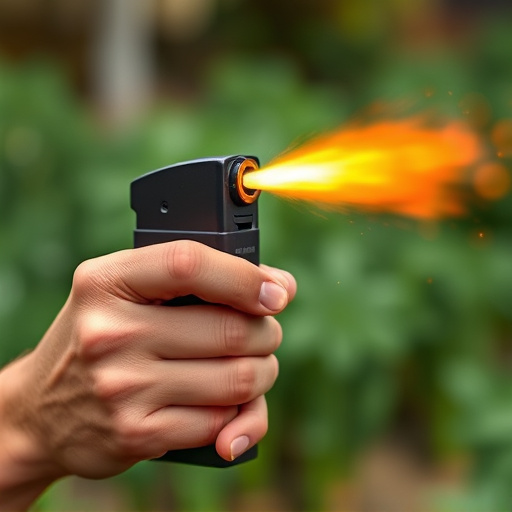The security landscape is shifting away from traditional firearms towards a diverse array of alternative weapons, driven by safety concerns, accessibility needs, and the desire for less-lethal options. These include non-lethal force tools like stun guns, pepper spray, tasers, and specialized ammunition, which are valuable in high-risk environments. This trend reflects a societal move towards de-escalation, community engagement, and well-being. Advanced surveillance technology, biometric scanners, AI drones, and non-lethal weapons further enhance security while prioritizing prevention and minimizing harm. Effective security programs now train personnel to use these alternative tools, which come with varying legal considerations depending on location.
In an era where security concerns are on the rise, individuals and communities are exploring diverse strategies beyond traditional firearms. This article delves into the shifting landscape of personal protection, uncovering a multifaceted approach to safety. We examine alternative weapons to guns, from physical self-defense techniques to cutting-edge security technology. By exploring training, legal aspects, and innovative solutions, readers will gain insights into enhancing preparedness in an increasingly complex world.
Understanding the Shift: Moving Beyond Traditional Guns
In today’s evolving landscape of security and self-defense, there’s a growing recognition that traditional firearms are no longer the sole or even primary option for many individuals and organizations. The shift towards alternative weapons to guns is driven by factors such as safety, accessibility, and the need for more versatile and less lethal options in diverse scenarios. This transformation reflects a broader societal move away from purely military-focused security towards strategies that prioritize de-escalation, community engagement, and the well-being of all parties involved.
The adoption of alternative weapons to guns comes with its own set of benefits. Non-lethal force tools, such as stun guns, pepper spray, tasers, and less-lethal ammunition, offer a range of options for handling threats without causing permanent harm. These alternatives are particularly valuable in high-risk environments like schools, events, and public spaces, where the use of firearms could have catastrophic consequences. By embracing these new security measures, we can foster safer communities while still maintaining effective protection.
Exploring Physical Self-Defense Options
In today’s world, personal security is a paramount concern for many individuals, leading them to explore various self-defense options beyond traditional firearms. One avenue gaining traction is the use of alternative weapons to guns, which offer unique advantages in different scenarios. These alternatives range from conventional melee weapons like batons and tasers to less lethal options such as pepper spray and stun guns, each designed to incapacitate or deter attackers without causing permanent harm.
The appeal lies in their accessibility, ease of use, and legality in many regions where firearms are tightly regulated. For instance, pepper spray is a popular choice for its quick knockdown effect and relatively low risk of injury. Similarly, stun guns, which emit electric currents to temporarily paralyze the target, provide a non-lethal means of self-defense. Exploring these alternative weapons empowers individuals to take control of their safety, ensuring they’re prepared should the unexpected occur in public spaces or within their homes.
The Role of Security Technology in Modern Times
In modern times, security technology has evolved significantly, offering a wide array of innovative solutions beyond traditional firearms. The world is witnessing a shift towards smarter, more efficient, and safer alternatives to guns for maintaining public and private security. These advancements are reshaping how we perceive and manage potential threats, focusing on prevention, early detection, and non-lethal intervention.
From advanced surveillance systems to sophisticated access control mechanisms and cutting-edge non-lethal weapons, technology provides a multitude of options. For instance, facial recognition software, biometric scanners, and AI-powered security drones enhance monitoring capabilities, while Tasers and other electric shock devices offer less lethal force as an alternative to firearms. These technologies not only bolster security measures but also promote a more nuanced approach to public safety, prioritizing de-escalation and minimizing harm.
Training and Preparedness: Essential Skills for All
In today’s evolving security landscape, focusing solely on traditional firearms as primary weapons is no longer sufficient. Training and preparedness are cornerstones of comprehensive security strategies, but they must adapt to include a broader range of skills and tools. Proficiency in alternative weapons to guns, such as pepper spray, tasers, or even non-lethal ballistic weapons, can significantly enhance an individual’s ability to protect themselves and others in high-risk situations.
Effective training programs should emphasize practical, hands-on experience with these alternative weapons. This includes learning proper usage, understanding legal implications, and developing strategies for de-escalation and crowd control. By equipping security personnel with diverse skill sets, they become more versatile, capable of responding to a wider array of threats, and ultimately, better prepared to navigate the complexities of modern security challenges.
Legal Considerations: Regulation and Ownership Rights
In many regions, the legal landscape surrounding alternative weapons to guns is complex and ever-evolving. Regulatory bodies often have strict guidelines on what constitutes a weapon and who can possess them, with ownership rights varying significantly based on location. These regulations aim to balance individual freedom with public safety, reflecting societal values and concerns about violence and security.
For instance, some jurisdictions allow the possession of non-lethal weapons like pepper spray, tasers, or stun guns for self-defense purposes, while others may restrict their use to law enforcement agencies only. Additionally, regulations on other alternative weapons—such as batons, tear gas, or even certain types of knives—can differ widely across countries and states. Understanding these legal considerations is crucial for anyone interested in acquiring an alternative weapon, as they not only dictate what’s permissible but also define the responsibilities associated with ownership.
